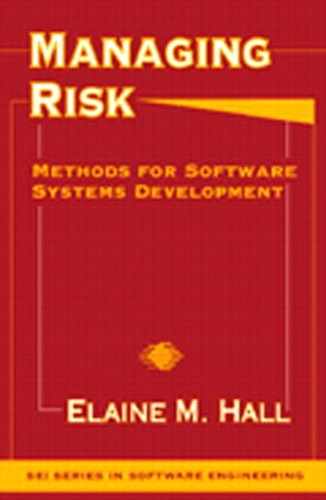Managing Risk:
Methods for Software Systems Development
![]()
Addison-Wesley
An Imprint of Addison Wesley Longman, Inc.
Reading, Massachusetts ![]() Harlow, England
Harlow, England ![]() Menlo Park, California
Menlo Park, California
Berkeley, California ![]() Don Mills, Ontario
Don Mills, Ontario ![]() Sydney
Sydney
Bonn ![]() Amsterdam
Amsterdam ![]() Tokyo
Tokyo ![]() Mexico City
Mexico City
Software Engineering Institute
The SEI Series in Software Engineering
Many of the designations used by manufacturers and sellers to distinguish their products are claimed as trademarks. Where those designations appear in this book, and Addison Wesley Longman, Inc. was aware of a trademark claim, the designations have been printed in initial capital letters or all capital letters.
The author and publisher have taken care in preparation of this book, but make no expressed or implied warranty of any kind and assume no responsibility for errors or omissions. No liability is assumed for incidental or consequential damages in connection with or arising out of the use of the information or programs contained herein.
The publisher offers discounts on this book when ordered in quantity for special sales. For more information please contact:
Corporate & Professional Publishing Group
Addison Wesley Longman, Inc.
One Jacob Way
Reading, Massachusetts 01867
Copyright © 1998 by Addison Wesley Longman, Inc.
Library of Congress Cataloging-in-Publication Data
Hall, Elaine M.
Managing risk: methods for software systems development / Elaine
M. Hall.
p. cm.—(SEI series in software engineering)
Includes bibliographical references and index.
ISBN 0-201-25592-8
1. Computer software. 2. Risk management. I. Title.
II. Series.
QA76.754.H346 1997
005.1‘068‘1—DC21
97–24703
CIP
All rights reserved. No part of this publication may be reproduced, stored in a retrieval system, or transmitted, in any form, or by any means, electronic, mechanical, photocopying, recording, or otherwise, without the prior consent of the publisher. Printed in the United States of America. Published simultaneously in Canada.
ISBN 0-201-25592-8
Text printed on acid-free and recycled paper.
1 2 3 4 5 6 7 8 9—MA—0201009998
First printing, January 1998
